CHEVROLET OPTRA 5 2006 1.G Workshop Manual
Manufacturer: CHEVROLET, Model Year: 2006, Model line: OPTRA 5, Model: CHEVROLET OPTRA 5 2006 1.GPages: 370, PDF Size: 2.32 MB
Page 51 of 370
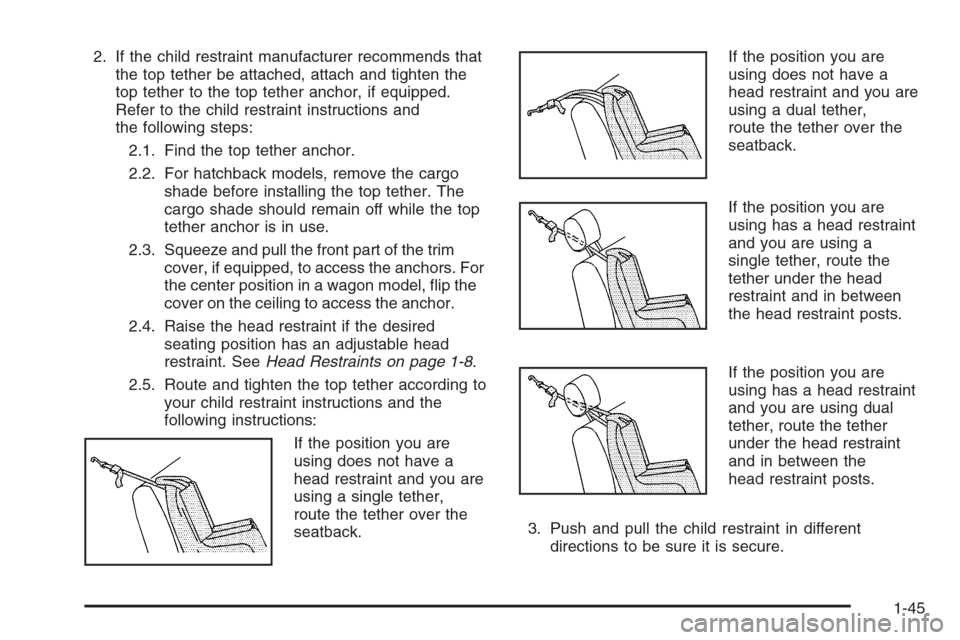
2. If the child restraint manufacturer recommends that
the top tether be attached, attach and tighten the
top tether to the top tether anchor, if equipped.
Refer to the child restraint instructions and
the following steps:
2.1. Find the top tether anchor.
2.2. For hatchback models, remove the cargo
shade before installing the top tether. The
cargo shade should remain off while the top
tether anchor is in use.
2.3. Squeeze and pull the front part of the trim
cover, if equipped, to access the anchors. For
the center position in a wagon model, flip the
cover on the ceiling to access the anchor.
2.4. Raise the head restraint if the desired
seating position has an adjustable head
restraint. SeeHead Restraints on page 1-8.
2.5. Route and tighten the top tether according to
your child restraint instructions and the
following instructions:
If the position you are
using does not have a
head restraint and you are
using a single tether,
route the tether over the
seatback.If the position you are
using does not have a
head restraint and you are
using a dual tether,
route the tether over the
seatback.
If the position you are
using has a head restraint
and you are using a
single tether, route the
tether under the head
restraint and in between
the head restraint posts.
If the position you are
using has a head restraint
and you are using dual
tether, route the tether
under the head restraint
and in between the
head restraint posts.
3. Push and pull the child restraint in different
directions to be sure it is secure.
1-45
Page 52 of 370
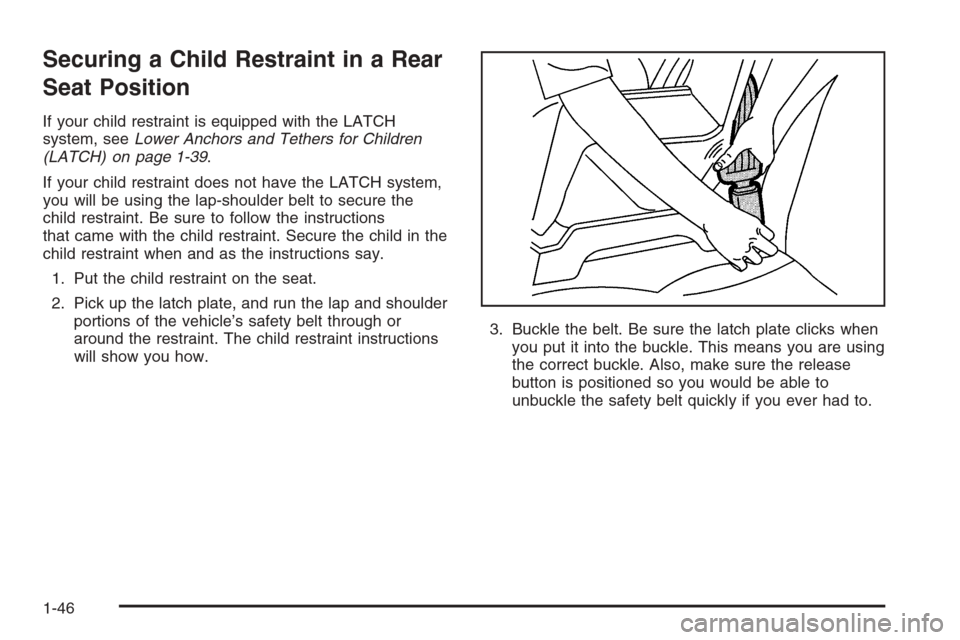
Securing a Child Restraint in a Rear
Seat Position
If your child restraint is equipped with the LATCH
system, seeLower Anchors and Tethers for Children
(LATCH) on page 1-39.
If your child restraint does not have the LATCH system,
you will be using the lap-shoulder belt to secure the
child restraint. Be sure to follow the instructions
that came with the child restraint. Secure the child in the
child restraint when and as the instructions say.
1. Put the child restraint on the seat.
2. Pick up the latch plate, and run the lap and shoulder
portions of the vehicle’s safety belt through or
around the restraint. The child restraint instructions
will show you how.3. Buckle the belt. Be sure the latch plate clicks when
you put it into the buckle. This means you are using
the correct buckle. Also, make sure the release
button is positioned so you would be able to
unbuckle the safety belt quickly if you ever had to.
1-46
Page 53 of 370
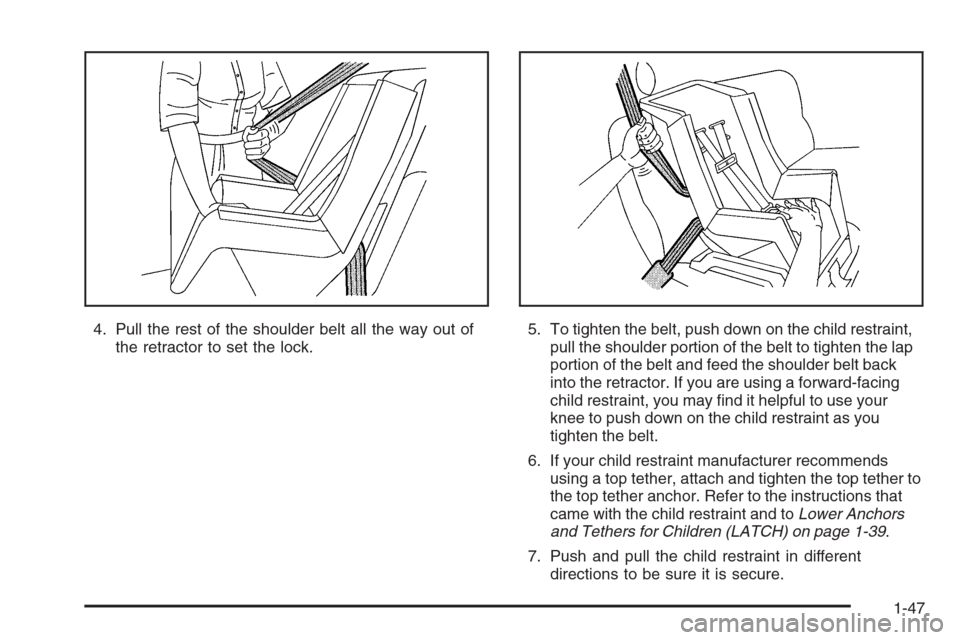
4. Pull the rest of the shoulder belt all the way out of
the retractor to set the lock.5. To tighten the belt, push down on the child restraint,
pull the shoulder portion of the belt to tighten the lap
portion of the belt and feed the shoulder belt back
into the retractor. If you are using a forward-facing
child restraint, you may find it helpful to use your
knee to push down on the child restraint as you
tighten the belt.
6. If your child restraint manufacturer recommends
using a top tether, attach and tighten the top tether to
the top tether anchor. Refer to the instructions that
came with the child restraint and toLower Anchors
and Tethers for Children (LATCH) on page 1-39.
7. Push and pull the child restraint in different
directions to be sure it is secure.
1-47
Page 54 of 370
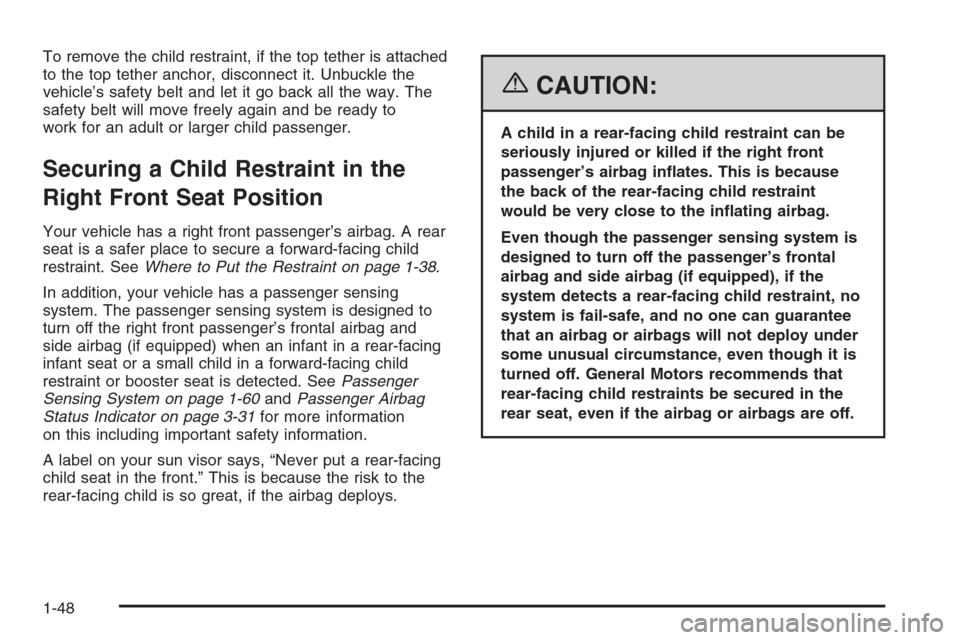
To remove the child restraint, if the top tether is attached
to the top tether anchor, disconnect it. Unbuckle the
vehicle’s safety belt and let it go back all the way. The
safety belt will move freely again and be ready to
work for an adult or larger child passenger.
Securing a Child Restraint in the
Right Front Seat Position
Your vehicle has a right front passenger’s airbag. A rear
seat is a safer place to secure a forward-facing child
restraint. SeeWhere to Put the Restraint on page 1-38.
In addition, your vehicle has a passenger sensing
system. The passenger sensing system is designed to
turn off the right front passenger’s frontal airbag and
side airbag (if equipped) when an infant in a rear-facing
infant seat or a small child in a forward-facing child
restraint or booster seat is detected. SeePassenger
Sensing System on page 1-60andPassenger Airbag
Status Indicator on page 3-31for more information
on this including important safety information.
A label on your sun visor says, “Never put a rear-facing
child seat in the front.” This is because the risk to the
rear-facing child is so great, if the airbag deploys.
{CAUTION:
A child in a rear-facing child restraint can be
seriously injured or killed if the right front
passenger’s airbag in�ates. This is because
the back of the rear-facing child restraint
would be very close to the in�ating airbag.
Even though the passenger sensing system is
designed to turn off the passenger’s frontal
airbag and side airbag (if equipped), if the
system detects a rear-facing child restraint, no
system is fail-safe, and no one can guarantee
that an airbag or airbags will not deploy under
some unusual circumstance, even though it is
turned off. General Motors recommends that
rear-facing child restraints be secured in the
rear seat, even if the airbag or airbags are off.
1-48
Page 55 of 370
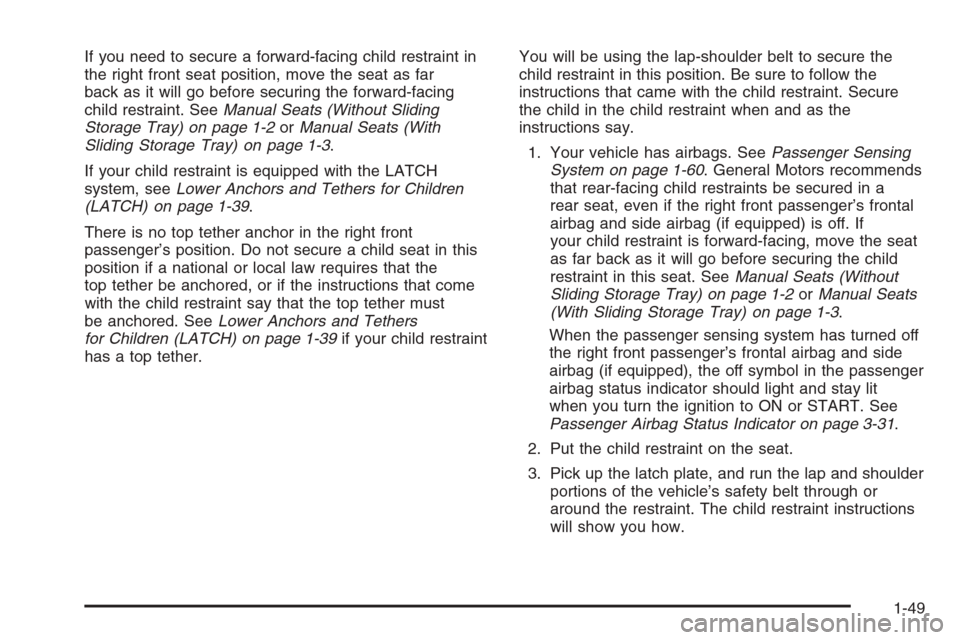
If you need to secure a forward-facing child restraint in
the right front seat position, move the seat as far
back as it will go before securing the forward-facing
child restraint. SeeManual Seats (Without Sliding
Storage Tray) on page 1-2orManual Seats (With
Sliding Storage Tray) on page 1-3.
If your child restraint is equipped with the LATCH
system, seeLower Anchors and Tethers for Children
(LATCH) on page 1-39.
There is no top tether anchor in the right front
passenger’s position. Do not secure a child seat in this
position if a national or local law requires that the
top tether be anchored, or if the instructions that come
with the child restraint say that the top tether must
be anchored. SeeLower Anchors and Tethers
for Children (LATCH) on page 1-39if your child restraint
has a top tether.You will be using the lap-shoulder belt to secure the
child restraint in this position. Be sure to follow the
instructions that came with the child restraint. Secure
the child in the child restraint when and as the
instructions say.
1. Your vehicle has airbags. SeePassenger Sensing
System on page 1-60. General Motors recommends
that rear-facing child restraints be secured in a
rear seat, even if the right front passenger’s frontal
airbag and side airbag (if equipped) is off. If
your child restraint is forward-facing, move the seat
as far back as it will go before securing the child
restraint in this seat. SeeManual Seats (Without
Sliding Storage Tray) on page 1-2orManual Seats
(With Sliding Storage Tray) on page 1-3.
When the passenger sensing system has turned off
the right front passenger’s frontal airbag and side
airbag (if equipped), the off symbol in the passenger
airbag status indicator should light and stay lit
when you turn the ignition to ON or START. See
Passenger Airbag Status Indicator on page 3-31.
2. Put the child restraint on the seat.
3. Pick up the latch plate, and run the lap and shoulder
portions of the vehicle’s safety belt through or
around the restraint. The child restraint instructions
will show you how.
1-49
Page 56 of 370
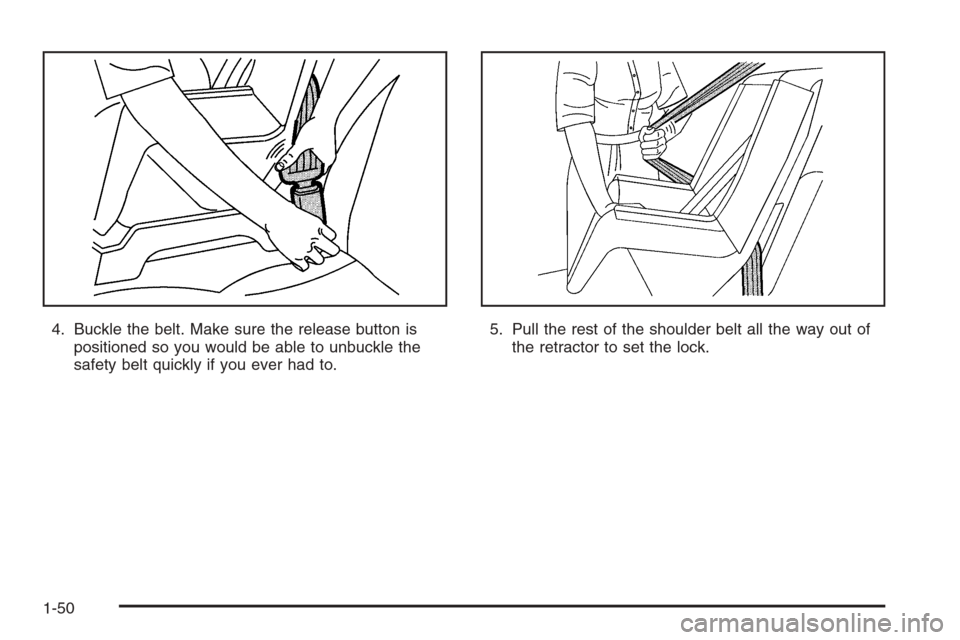
4. Buckle the belt. Make sure the release button is
positioned so you would be able to unbuckle the
safety belt quickly if you ever had to.5. Pull the rest of the shoulder belt all the way out of
the retractor to set the lock.
1-50
Page 57 of 370
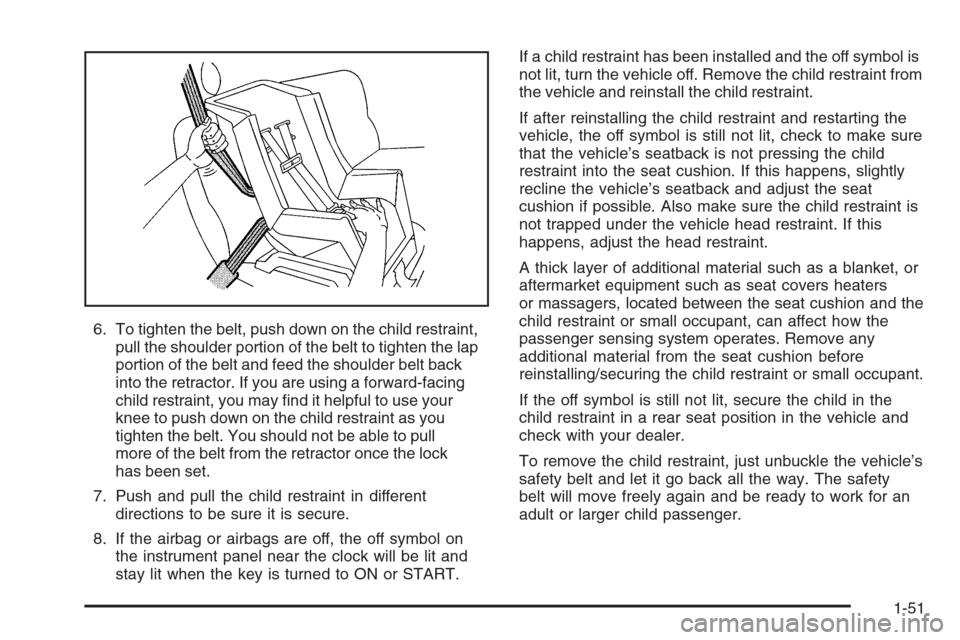
6. To tighten the belt, push down on the child restraint,
pull the shoulder portion of the belt to tighten the lap
portion of the belt and feed the shoulder belt back
into the retractor. If you are using a forward-facing
child restraint, you may find it helpful to use your
knee to push down on the child restraint as you
tighten the belt. You should not be able to pull
more of the belt from the retractor once the lock
has been set.
7. Push and pull the child restraint in different
directions to be sure it is secure.
8. If the airbag or airbags are off, the off symbol on
the instrument panel near the clock will be lit and
stay lit when the key is turned to ON or START.If a child restraint has been installed and the off symbol is
not lit, turn the vehicle off. Remove the child restraint from
the vehicle and reinstall the child restraint.
If after reinstalling the child restraint and restarting the
vehicle, the off symbol is still not lit, check to make sure
that the vehicle’s seatback is not pressing the child
restraint into the seat cushion. If this happens, slightly
recline the vehicle’s seatback and adjust the seat
cushion if possible. Also make sure the child restraint is
not trapped under the vehicle head restraint. If this
happens, adjust the head restraint.
A thick layer of additional material such as a blanket, or
aftermarket equipment such as seat covers heaters
or massagers, located between the seat cushion and the
child restraint or small occupant, can affect how the
passenger sensing system operates. Remove any
additional material from the seat cushion before
reinstalling/securing the child restraint or small occupant.
If the off symbol is still not lit, secure the child in the
child restraint in a rear seat position in the vehicle and
check with your dealer.
To remove the child restraint, just unbuckle the vehicle’s
safety belt and let it go back all the way. The safety
belt will move freely again and be ready to work for an
adult or larger child passenger.
1-51
Page 58 of 370
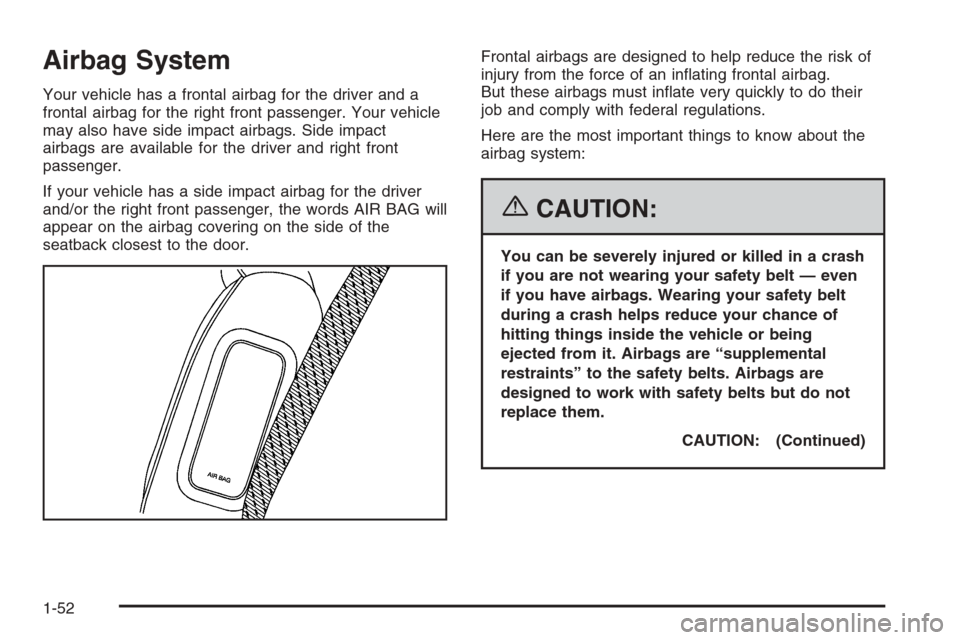
Airbag System
Your vehicle has a frontal airbag for the driver and a
frontal airbag for the right front passenger. Your vehicle
may also have side impact airbags. Side impact
airbags are available for the driver and right front
passenger.
If your vehicle has a side impact airbag for the driver
and/or the right front passenger, the words AIR BAG will
appear on the airbag covering on the side of the
seatback closest to the door.Frontal airbags are designed to help reduce the risk of
injury from the force of an inflating frontal airbag.
But these airbags must inflate very quickly to do their
job and comply with federal regulations.
Here are the most important things to know about the
airbag system:
{CAUTION:
You can be severely injured or killed in a crash
if you are not wearing your safety belt — even
if you have airbags. Wearing your safety belt
during a crash helps reduce your chance of
hitting things inside the vehicle or being
ejected from it. Airbags are “supplemental
restraints” to the safety belts. Airbags are
designed to work with safety belts but do not
replace them.
CAUTION: (Continued)
1-52
Page 59 of 370
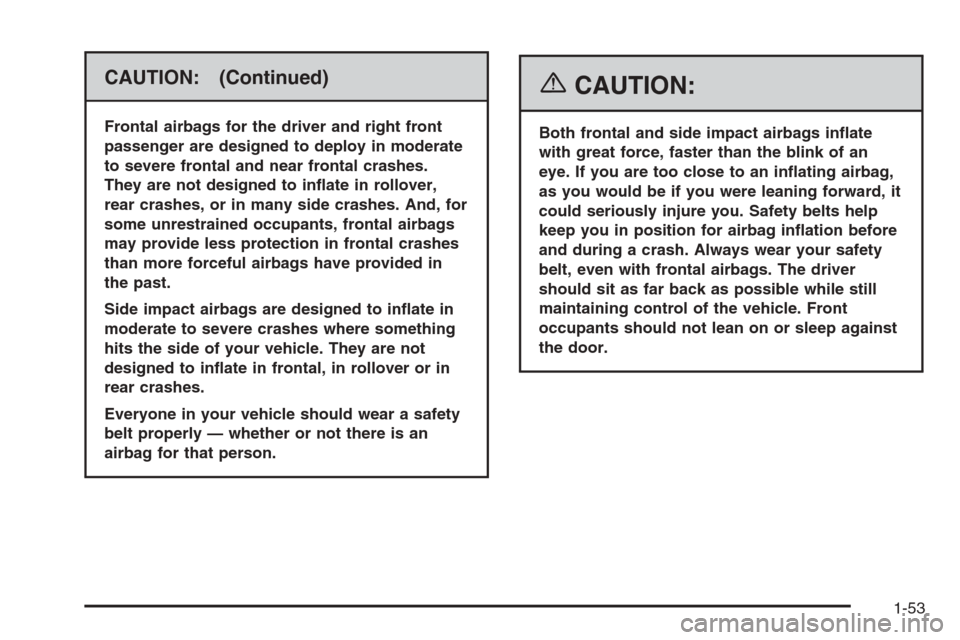
CAUTION: (Continued)
Frontal airbags for the driver and right front
passenger are designed to deploy in moderate
to severe frontal and near frontal crashes.
They are not designed to in�ate in rollover,
rear crashes, or in many side crashes. And, for
some unrestrained occupants, frontal airbags
may provide less protection in frontal crashes
than more forceful airbags have provided in
the past.
Side impact airbags are designed to in�ate in
moderate to severe crashes where something
hits the side of your vehicle. They are not
designed to in�ate in frontal, in rollover or in
rear crashes.
Everyone in your vehicle should wear a safety
belt properly — whether or not there is an
airbag for that person.
{CAUTION:
Both frontal and side impact airbags in�ate
with great force, faster than the blink of an
eye. If you are too close to an in�ating airbag,
as you would be if you were leaning forward, it
could seriously injure you. Safety belts help
keep you in position for airbag in�ation before
and during a crash. Always wear your safety
belt, even with frontal airbags. The driver
should sit as far back as possible while still
maintaining control of the vehicle. Front
occupants should not lean on or sleep against
the door.
1-53
Page 60 of 370
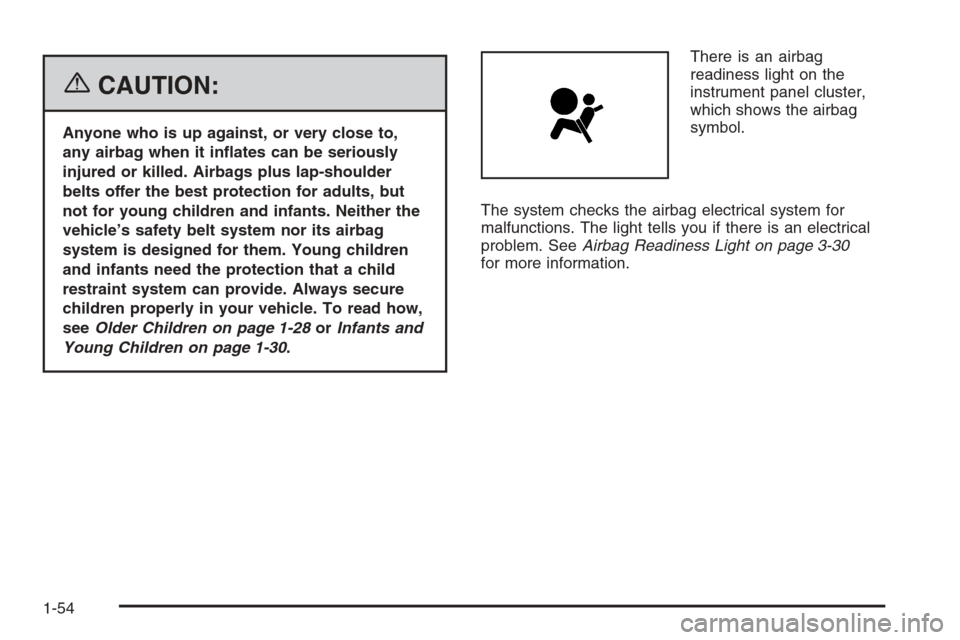
{CAUTION:
Anyone who is up against, or very close to,
any airbag when it in�ates can be seriously
injured or killed. Airbags plus lap-shoulder
belts offer the best protection for adults, but
not for young children and infants. Neither the
vehicle’s safety belt system nor its airbag
system is designed for them. Young children
and infants need the protection that a child
restraint system can provide. Always secure
children properly in your vehicle. To read how,
seeOlder Children on page 1-28orInfants and
Young Children on page 1-30.There is an airbag
readiness light on the
instrument panel cluster,
which shows the airbag
symbol.
The system checks the airbag electrical system for
malfunctions. The light tells you if there is an electrical
problem. SeeAirbag Readiness Light on page 3-30
for more information.
1-54